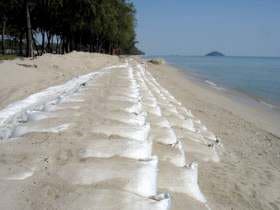Secutex / Terrafix
Needlepunched Terrafix Soft Rock® nonwoven geotextile container.
Description
Soft Rock geotextile containers for soil containment transform erosion-prone local materials into an erosion-resistant system through the utilization of needlepunched nonwoven Terrafix® or Secutex® geotextiles.
It is well-suited to erosion control in waterfront construction, beach renourishment, scour protection, artificial reef construction and many other applications that require exceptional strength, the flexibility to conform to uneven terrain, and long-term performance.
Terrafix Soft Rock® RS offers an additional attached coarser geotextile on the outside. The uniquely durable nonwoven geotextile provides elevated UV-resistance, higher protection against vandalism and numerous environmental advantages.
Needlepunched Terrafix Soft Rock® nonwoven geotextile containers can withstand harsh installation conditions, such as uneven terrain and tides, and challenging construction loads, such as heavy riprap. With the additional attached Soft Rock RS protection layer the added robustness also helps to protect against vandalism – a major benefit in any public waterfront installation. Terrafix® also demonstrates outstanding elongation properties due to its flexible, non-brittle, three-dimensional needlepunched fibre matrix.
The entangled fibres retain soil particles, for cleaner and more dependable performance. Also, additional erosion control is promoted through vegetation establishment (Plant roots can hold to the fibres). Marine life can grow and flourish upon Terrafix Soft Rock® RS without damaging the containers. The unique interaction of robustness and flexibility provides high puncture resistance without sacrificing frictional or filtration properties – an excellent choice for hydraulic and sustainable engineering applications.
Whether it’s a revetment structure, scour protection, beach repair or another geotextile container application, one must be concerned with both – the overall resistance to environmental threats such as wave energy and scour and the friction with other comparable solutions themselves. As waves push and pull at the Terrafix Soft Rock® structures, the individual containers may rub against one another.
The durable, flexible fibre matrix of Terrafix® nonwoven geotextiles possesses elongation characteristics that are not only high but likely superior to woven geotextiles. Nonwovens are more flexible and possess a higher resistance to puncture and puncture resistance may be a determining factor when using local materials rather than expensive, specially prepared fill materials.
The strength of Terrafix Soft Rock® with its nonwoven geotextile greatly outperforms other solutions in regards to these vital design and performance concerns. Additionally, Terrafix Soft Rock® RS has a white bottom layer with a coulored layer for additional UV resistance, as anti-vandalism protection layer and for improved under water habitant growth.
Beyond the long-term durability benefits provided by the robustness of NAUE´s Terrafix Soft Rock®, installations are also more secure. Some installation conditions can damage many types of geosynthetics. Terrafix® geotextiles eliminate that risk. The combination of strength and flexibility allows for rough handling (such as dropping bags into place), covering with heavy riprap and placement over uneven ground. Also, the additional geotextile puncture resistance of Soft Rock RS better protects against vandalism. Safer, more intact installations lead to maximized performance and longer service life.
Terrafix Soft Rock® possesses many environmental advantages. Nonwoven Terrafix® containers have a rough, durable outer surface to which plant life and other organisms can hold. This allows for underwater plant growth that provides additional erosion control and site protection while creating a habitat zone. For applications such as artificial reef construction, the characteristics of Terrafix Soft Rock® are essential to environmental success.
For other installations, such as beachfront erosion control, the ability to use local material controls site costs, minimizes site disturbance, and reduces the carbon footprint of construction. Harvesting fill is both expensive and environmentally harsh, as it requires stripping and shipping it from elsewhere. Each day we see more and more how greener practices are not just nice ideas but economically smart.
Product specification sheet
Secutex / Terrafix product specification sheet opens in a new windowManufacturer
Global Synthetics







